Sketch (drawing)
A sketch (ultimately from Greek σχέδιος – schedios, "done extempore"[1][2][3]) is a rapidly executed freehand drawing that is not usually intended as a finished work.[4] A sketch may serve a number of purposes: it might record something that the artist sees, it might record or develop an idea for later use or it might be used as a quick way of graphically demonstrating an image, idea or principle.


Sketches can be made in any drawing medium. The term is most often applied to graphic work executed in a dry medium such as silverpoint, graphite, pencil, charcoal or pastel. It may also apply to drawings executed in pen and ink, digital input such as a digital pen, ballpoint pen, marker pen, water colour and oil paint. The latter two are generally referred to as "water colour sketches" and "oil sketches". A sculptor might model three-dimensional sketches in clay, plasticine or wax.
Applications of sketching
Sketching is generally a prescribed part of the studies of art students.[5] This generally includes making sketches (croquis) from a live model whose pose changes every few minutes. A "sketch" usually implies a quick and loosely drawn work, while related terms such as study, modello and "preparatory drawing" usually refer to more finished and careful works to be used as a basis for a final work, often in a different medium, but the distinction is imprecise. Underdrawing is drawing underneath the final work, which may sometimes still be visible, or can be viewed by modern scientific methods such as X-rays.
Most visual artists use, to a greater or lesser degree, the sketch as a method of recording or working out ideas. The sketchbooks of some individual artists have become very well known,[4] including those of Leonardo da Vinci and Edgar Degas which have become art objects in their own right, with many pages showing finished studies as well as sketches. The term "sketchbook" refers to a book of blank paper on which an artist can draw (or has already drawn) sketches. The book might be purchased bound or might comprise loose leaves of sketches assembled or bound together.[6]
Sketching is also used as a form of communication in areas of product design such as industrial design. It can be used to communicate design intent and is most widely used in ideation[7][8] It can be used to map out floor plans of homes.[9]
The ability to quickly record impressions through sketching has found varied purposes in today's culture. Courtroom sketches record scenes and individuals in law courts. Sketches drawn to help authorities find or identify wanted people are called composite sketches. Street artists in popular tourist areas sketch portraits within minutes.[5]
Gallery
- Subjects, styles and media
 Three draft sketches in sepia for an equestrian monument, Leonardo da Vinci 1508–10
Three draft sketches in sepia for an equestrian monument, Leonardo da Vinci 1508–10 Sketch in pen and ink of an idea for a flying machine with a spiral rotor, Leonardo da Vinci.
Sketch in pen and ink of an idea for a flying machine with a spiral rotor, Leonardo da Vinci. Sketch of a head in a parade helmet, Michelangelo, c. 1500
Sketch of a head in a parade helmet, Michelangelo, c. 1500 Figure sketch in ink of two women teaching a baby to walk, Carel Fabritius, c. 1640
Figure sketch in ink of two women teaching a baby to walk, Carel Fabritius, c. 1640
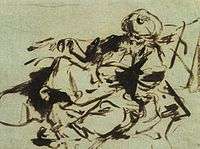 The Pasha, an ink sketch by Jean-Honoré Fragonard, late 1700s
The Pasha, an ink sketch by Jean-Honoré Fragonard, late 1700s An oil sketch of clouds by John Constable, 1821–22
An oil sketch of clouds by John Constable, 1821–22 A sketch of a landscape in pencil by Camille Corot, 1870
A sketch of a landscape in pencil by Camille Corot, 1870 Nocturene-Battersea Bridge, a pastel sketch by Whistler, 1872
Nocturene-Battersea Bridge, a pastel sketch by Whistler, 1872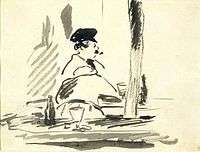 Le Bouchon, a brush and ink sketch by Édouard Manet, 1878
Le Bouchon, a brush and ink sketch by Édouard Manet, 1878 A girl in a rowing boat, pencil, ink and watercolour, Pierre-Auguste Renoir, 1870s
A girl in a rowing boat, pencil, ink and watercolour, Pierre-Auguste Renoir, 1870s A landscape sketch in brush and ink with washes, Paul Cézanne, (1888–90)
A landscape sketch in brush and ink with washes, Paul Cézanne, (1888–90) Oil sketch Child in a hat with a black rosette, Mary Cassatt, c. 1910
Oil sketch Child in a hat with a black rosette, Mary Cassatt, c. 1910 Sketch of a reclining nude in brush and ink washes, Lajos Tihanyi, 1910
Sketch of a reclining nude in brush and ink washes, Lajos Tihanyi, 1910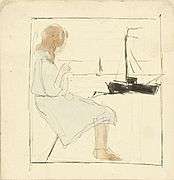 Girl Knitting by the Sea, pencil and watercolour by Theo van Doesburg, 1918
Girl Knitting by the Sea, pencil and watercolour by Theo van Doesburg, 1918 Two ink sketches of Krishna playing the Flute, van Doesburg, early 20th century
Two ink sketches of Krishna playing the Flute, van Doesburg, early 20th century Sketch of a male nude in black crayon, Egon Schiele, 1918
Sketch of a male nude in black crayon, Egon Schiele, 1918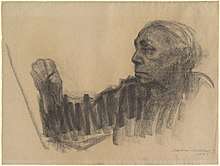 Kathe Kollwitz, "Self Portrait", charcoal on brown laid Ingres paper, 1933
Kathe Kollwitz, "Self Portrait", charcoal on brown laid Ingres paper, 1933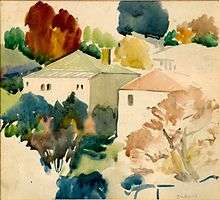 Watercolour landscape sketch, John Weeks, c. 1950
Watercolour landscape sketch, John Weeks, c. 1950 Court sketch from the New Haven Black Panther trials, Robert Templeton, 1971
Court sketch from the New Haven Black Panther trials, Robert Templeton, 1971
See also
References
- sketch Archived 2011-01-30 at the Wayback Machine, on Oxford Dictionaries
- Douglas Harper. "Online Etymology Dictionary – Sketch". Archived from the original on 2011-09-19.
- σχέδιος Archived 2011-06-29 at the Wayback Machine, Henry George Liddell, Robert Scott, A Greek-English Lexicon, on Perseus
- Diana Davies (editor), Harrap's Illustrated Dictionary of Art and Artists, Harrap Books Limited, (1990) ISBN 0-245-54692-8
- Cf. Sue Bleiweiss, The Sketchbook Challenge, Potter Craft, 2012, pp. 10–13.
- Cf. Richard Brereton, Sketchbooks: The Hidden Art of Designers, Illustrators & Creatives, Laurence King, repr. ed. 2012.
- Jonson, Ben (November 2005). "Design ideation: the conceptual sketch in the digital age". Design Studies. 26 (6): 613–624. doi:10.1016/j.destud.2005.03.001. ISSN 0142-694X.
- Fowles, Robert A. (July 1979). "Design methods in UK schools of architecture". Design Studies. 1 (1): 15–16. doi:10.1016/0142-694x(79)90022-x. ISSN 0142-694X.
- Zhou, Ling (2017-03-01). "How to use Sketch to design floor plans". Design + Sketch. Retrieved 2018-07-22.
Sources
- Chisholm, Hugh, ed. (1911). . Encyclopædia Britannica. 25 (11th ed.). Cambridge University Press. p. 186.
External links
